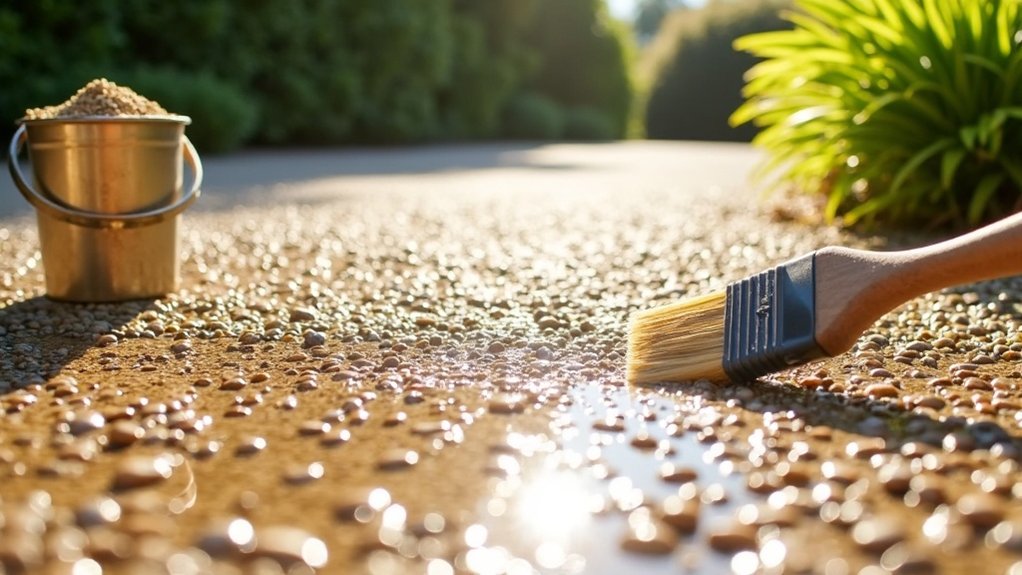Quick action with absorbent materials like cat litter or sawdust is crucial when oil or grease spills onto resin-bound gravel. Once soaked up, wash the affected area with warm water and washing-up liquid, then rinse well. A quality sealant applied every 2-3 years, combined with regular brushing and gentle cleaning, will help prevent stubborn stains. Think of the sealant as a protective coat – much like waxing your car – creating a barrier against oil and grease damage.
Key Takeaways
Five key steps to protect resin-bound gravel from oil stains:
- Apply a premium sealant every 2-3 years – think of it like waxing your car to protect the paintwork.
- Sort spills straight away with cat litter or sawdust. The quicker you act, the less likely it’ll stain.
- Give it a regular sweep to clear leaves and twigs – just as you’d sweep your patio to keep it tidy.
- Clean thoroughly each season with mild, pH-neutral soap. Avoid harsh chemicals that might damage the surface.
- Check the drainage often – standing water is your driveway’s worst enemy and can leave nasty marks.
Immediate Spill Response Techniques
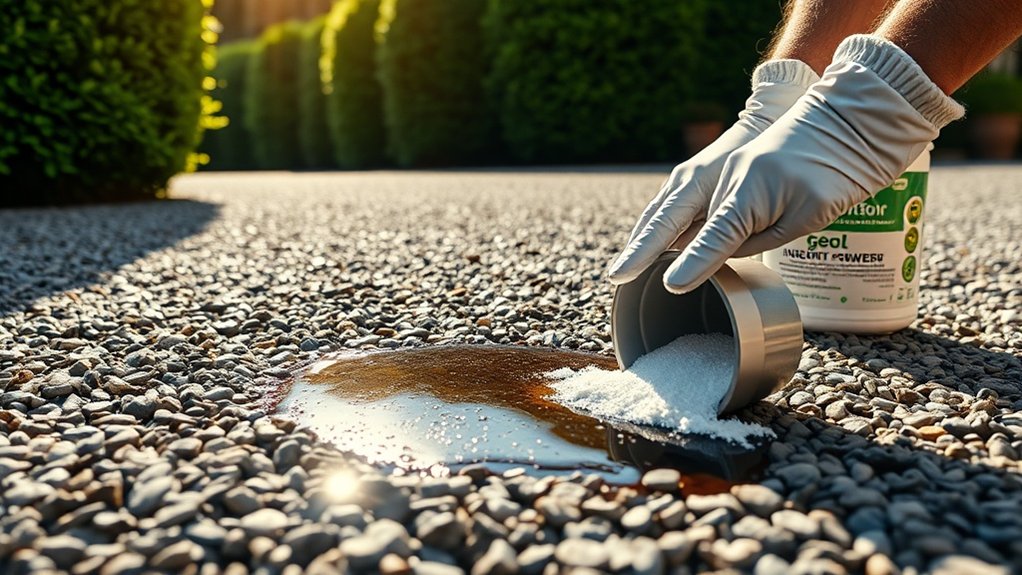
Quick action is vital when oil or grease spills onto resin-bound gravel to stop permanent staining. For best results, cover the spill straight away with absorbent materials like cat litter (clay-based works best), sawdust or bicarbonate of soda. Regular maintenance and weed control can also help minimize potential staining from spills.
Leave the absorbent to work for several hours, ideally overnight, to soak up as much oil as possible. Once absorbed, clean the area with washing-up liquid mixed with warm water, scrubbing gently to break down any leftover grease.
Give it a thorough rinse to wash away all residue. Mind you don’t use harsh chemicals, as these could harm the resin surface. The quicker you act and the better your choice of absorbent, the more likely you’ll keep your gravel looking proper. Regular cleaning and maintenance ensure that the driveway’s permeability remains intact, which is crucial for preventing further damage.
Application of Preventative Sealants
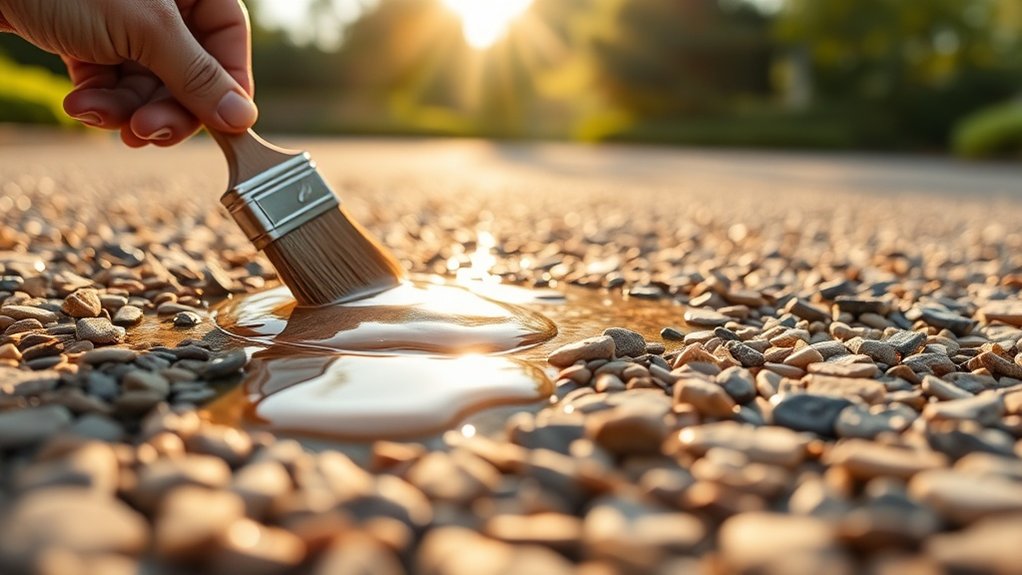
Applying protective sealants is vital to shield your resin-bound gravel from stains and weather damage. A careful, step-by-step process ensures proper bonding and lasting protection – much like applying a quality wood varnish. Choose a high-grade sealant and apply it methodically across the surface, paying special attention to high-traffic areas. Regular maintenance checks and timely resealing, typically every 2-3 years depending on usage, will keep your surface in top condition. Resin bound gravel’s durability against various weather conditions makes it essential to maintain its protective layer. Properly applied sealants can also enhance the surface’s ability to resist oil marks and stains, making it easier to maintain over time. Quality sealants might cost more initially but prove worthwhile by extending the life of your resin-bound surface.
Importance of Sealants
Sealants play a vital role in protecting resin-bound gravel, much like a raincoat shields you from wet weather. These protective coatings create a barrier that stops water, oil and chemicals from seeping into the surface. Regularly applying a sealant can help ensure that the surface maintains proper drainage maintenance and reduces the likelihood of water pooling, which can lead to erosion.
Think of it as waterproofing your driveway or patio – the sealant keeps the gravel looking fresh whilst making it tougher against daily wear and tear. Additionally, applying sealants enhances the environmental impact of your driveway by reducing the need for frequent cleaning and maintenance.
The benefits are straightforward:
- Stops stains from oil and grease
- Makes cleaning much easier
- Protects against UV damage
- Extends the life of your gravel surface
Just as you’d regularly maintain your car, applying sealant every few years keeps your resin-bound gravel in top condition.
It’s particularly important in Britain’s wet climate, where moisture can be particularly damaging. Without proper sealing, your investment could deteriorate faster than necessary, leading to costly repairs down the line.
Application Process Overview
Preparing to Seal Resin-Bound Gravel
Ensure your resin-bound gravel is clean, cured and debris-free before applying a preventative sealant. Choose either a water-based or solvent-based sealant suitable for porous surfaces.
| Step | Action | Purpose |
|---|---|---|
| Surface Cleaning | Remove dust and debris | Ensures proper adhesion |
| Sealant Selection | Choose UV-stable sealants | Maximises oil and grease protection |
| Application Technique | Use rollers or brushes | Ensures even coverage |
| Curing Conditions | Maintain 10-30°C and low humidity | Promotes optimal curing |
These steps will ensure a successful application and lasting protection against stains. Think of the sealant as a protective coat – much like waterproofing a jacket – it needs the right conditions and preparation to work effectively.
Maintenance and Reapplication Tips
Essential Care for Resin-Bound Surfaces
Regular checks and cleaning are vital to protect your resin-bound gravel from stains and wear. Simple maintenance keeps your surface looking fresh and extends its lifespan.
Key maintenance steps:
- Tackle oil and grease with specialist cleaners like BOUNDCLEAN
- Power wash thoroughly before sealing to ensure proper bonding
- Top up sealant every 1-3 years depending on use and weather
- Look out for stains during wet months, particularly fallen leaves in autumn
Best results come from sorting problems quickly – a quick sweep and occasional deep clean will keep your surface in top condition.
Routine Cleaning and Maintenance Practices
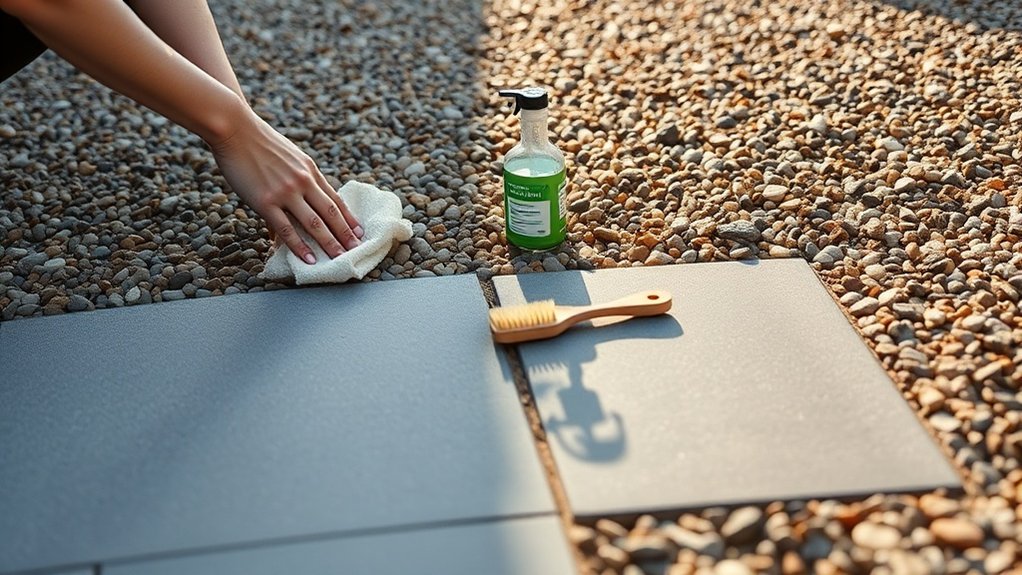
Keep your resin-bound gravel looking its best with simple maintenance.
Sweep weekly to remove leaves, twigs and general rubbish that might stain or damage the surface.
Give it a thorough clean each season – just like you’d wash your car.
Stick to gentle cleaning products; harsh chemicals can damage the resin and stop water draining properly through the surface.
Weekly Sweeping Importance
Regular sweeping of your resin-bound gravel is essential for keeping it looking smart and structurally sound. Proper sweeping removes debris whilst preventing unwanted oil and grease marks.
Key benefits of weekly sweeping:
- Clears away loose dirt and fallen leaves that can trap oil
- Stops dirt from building up and causing discolouration
- Works best with a stiff brush using circular movements
- Keeps moss and algae at bay, reducing grimy patches
A quick rinse with the garden hose after sweeping helps wash away any remaining dust.
This simple weekly task helps your surface last longer, cuts down on costly repairs, and lets you spot potential problems before they worsen.
Making this a regular habit will keep your resin-bound gravel in top condition.
Seasonal Deep Cleaning
Regular Deep Clean Through the Seasons
Give your resin-bound driveway a proper clean as the seasons shift to keep it looking smart and working well. First, sweep away loose bits and pieces – this makes the washing part much easier.
Use your garden hose or pressure washer, but keep it under 150 bar to avoid damage. Hold the nozzle about 20cm away and work back and forth across the surface.
Once clean, check for any winter wear and tear, particularly cracks that might need fixing with matching resin. Pull out any weeds and look for sun damage – you might need to apply a UV sealer.
Don’t forget to check your drainage channels are clear to stop puddles forming.
This basic maintenance keeps your driveway in tip-top shape and helps avoid costly repairs down the line.
Avoiding Harsh Chemicals
Harsh Chemicals: Best Avoided
Strong cleaning products might seem effective, but they’ll damage your resin-bound gravel over time. These chemicals break down the resin binding, causing unsightly discolouration and surface weakness.
Natural and eco-friendly cleaners work better for day-to-day maintenance.
Simple care tips:
- Choose mild, pH-neutral soap solutions
- Give it a regular sweep with a stiff-bristled broom
- Wash gently with a garden hose on low pressure
- For oil spills, sprinkle cat litter and sweep once absorbed
Use of Absorbents for Stain Control
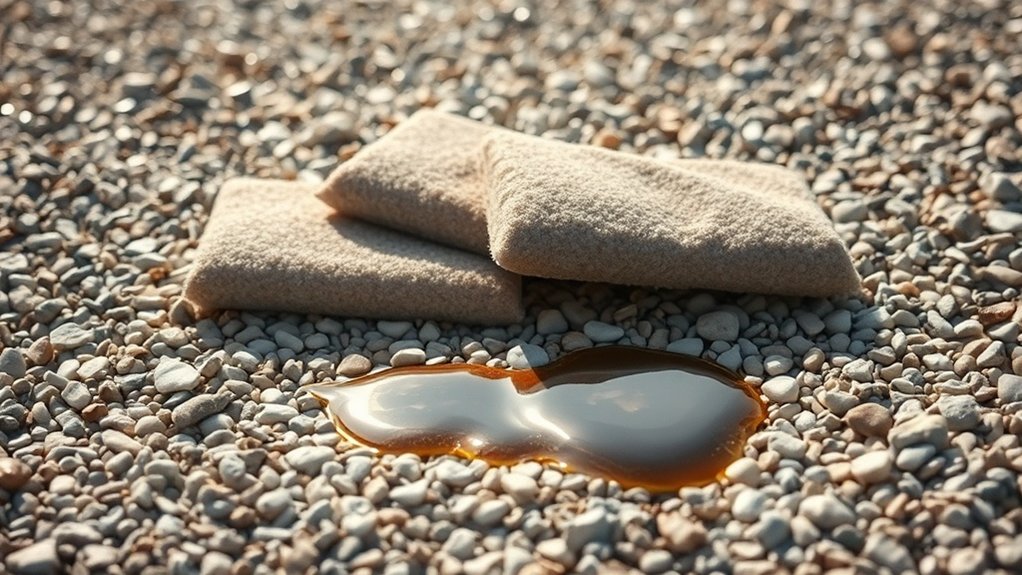
Using absorbents is vital for tackling oil and grease stains on resin-bound gravel.
Common household items like cat litter, sawdust or bentonite clay work brilliantly for fresh spills – much like blotting a coffee stain with kitchen roll.
Choose absorbents with strong soaking power that won’t stain your resin surface.
Simply pour plenty of your chosen absorbent over the affected area straight away and leave it for several hours or overnight.
Stubborn stains might need a second go.
Once done, sweep up thoroughly without washing down.
This approach stops oils from seeping deeper whilst keeping your gravel looking smart, and you won’t need harsh cleaning products.
Mechanical and Chemical Stain Removal Methods
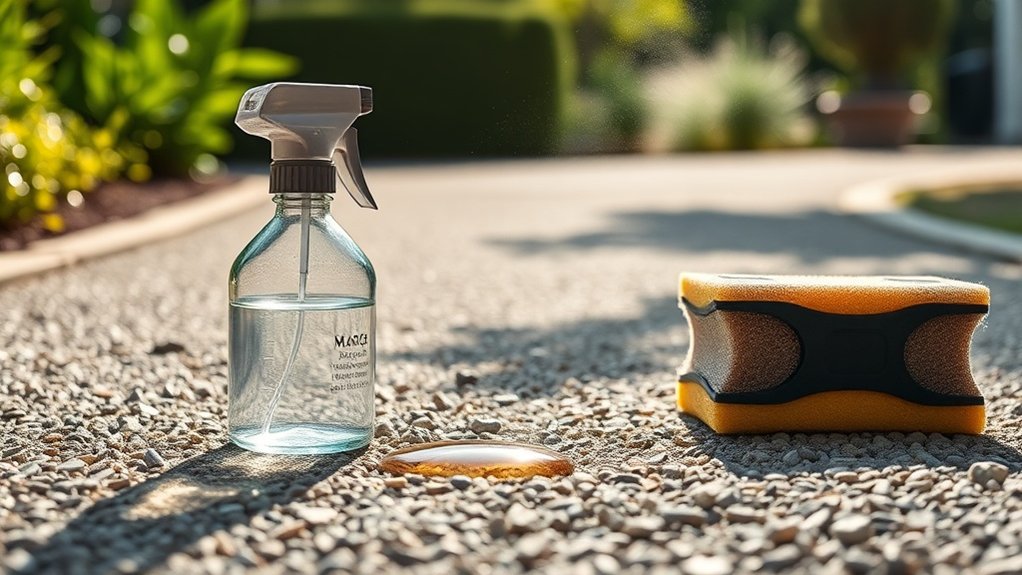
Dealing with stubborn stains on resin-bound gravel requires proper cleaning methods to protect your surface.
Essential techniques include:
- Gentle scrubbing with soft or stiff brushes to avoid damaging the resin
- Application of mild detergents or specialist degreasers (check product compatibility first)
- Thorough rinsing to prevent dirt-attracting residue
- Pressure washing at max 150 bar, keeping the lance 200mm from the surface
Regular maintenance using these methods helps preserve your gravel’s appearance whilst preventing long-term oil and grease damage.
Common household detergents like washing-up liquid often work well for lighter stains, whilst tougher marks might need purpose-made cleaners from your local DIY shop.
Weed, Moss, and Algae Prevention Strategies
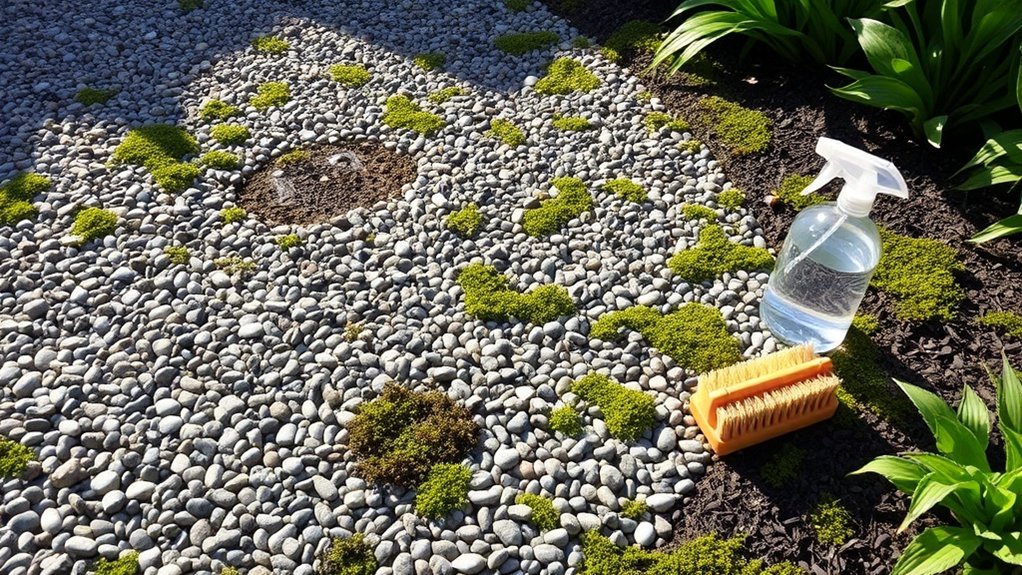
Effective Prevention of Weeds, Moss and Algae on Resin-Bound Gravel
A practical approach combining barriers, upkeep and environmental control best prevents unwanted growth on resin-bound surfaces. Essential strategies include:
| Strategy | Description |
|---|---|
| Weed Membrane | Fit a quality weed membrane underneath your gravel surface |
| Regular Cleaning | Simply sweep or blow away leaves and debris weekly |
| Vegetation Management | Cut back any overhanging plants to reduce damp patches |
| Targeted Treatment | Apply suitable weed killers and moss treatments as needed |
These methods work particularly well for British weather conditions, where damp environments often encourage moss growth. Keeping on top of basic maintenance will save you time and money in the long run, whilst keeping your driveway or path looking smart throughout the year.
Regular Inspections and Maintenance Tips
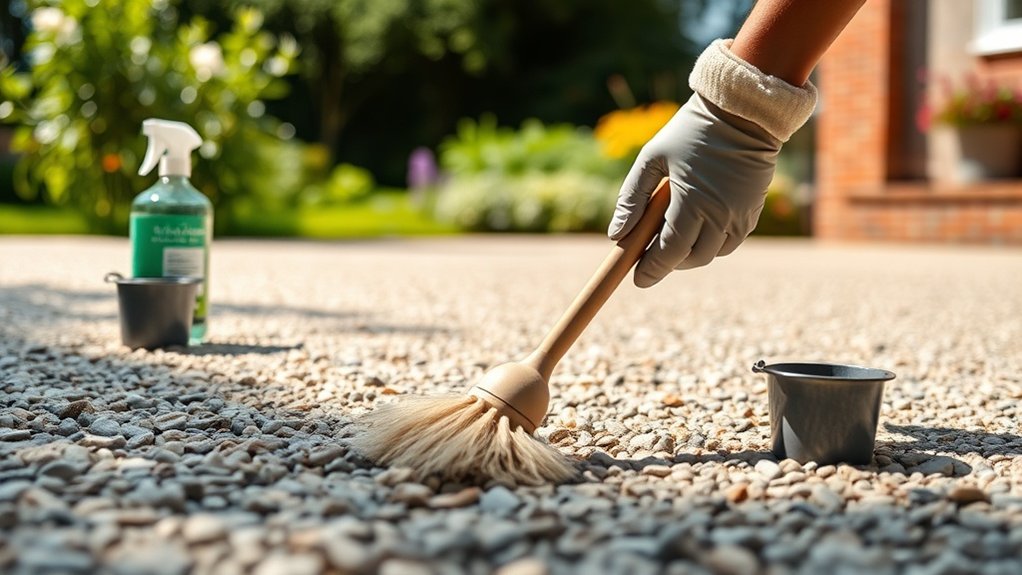
Regular checks and upkeep are vital to maintain your resin-bound gravel’s quality and looks. Follow this straightforward maintenance plan:
- Check the surface yearly for wear and fading (best done in spring after winter weather)
- Sweep weekly with a stiff brush to stop leaves and dirt becoming trapped
- Monitor drainage monthly, particularly after British downpours
- Clean up any oil or petrol spills straight away using a specialist cleaner from your local DIY shop
Remember: A well-maintained resin-bound driveway can last 15-20 years, whilst a neglected one might need replacing in half that time.
Frequently Asked Questions
Can Resin-Bound Gravel Be Installed Over Existing Asphalt or Concrete?
Yes, resin-bound gravel can be laid over existing asphalt or concrete surfaces, provided the base is structurally sound. The key is proper preparation – ensure the surface is thoroughly cleaned, any cracks are repaired, and the base material is compatible with the resin binding. Much like painting a wall, the quality of the groundwork directly affects the final result and longevity of the installation.
How Long Does a Sealant Last on Resin-Bound Surfaces?
A quality sealant typically lasts three to five years on resin-bound surfaces when properly maintained. Regular cleaning with a pressure washer and annual inspections help maximise its durability. Much like caring for a car’s paintwork, proper maintenance shields the surface from Britain’s weather, including rain, frost and UV exposure.
Are There Eco-Friendly Cleaning Options for Resin-Bound Gravel?
Eco-friendly cleaning solutions work brilliantly on resin-bound gravel driveways and paths. Simply use biodegradable washing-up liquid or natural alternatives like white vinegar mixed with warm water. For stubborn marks, a paste of bicarbonate of soda does the job nicely. These gentle cleaners maintain your surface whilst being kind to British gardens and wildlife.
What Tools Are Best for Cleaning Resin-Bound Gravel?
Stiff-bristled brushes and low-powered pressure washers are ideal for cleaning resin-bound gravel driveways and paths. A pH-neutral cleaning solution, much like what you’d use on natural stone, works best for removing stubborn stains. For day-to-day upkeep, a soft-bristled broom keeps leaves and debris at bay whilst protecting the surface finish.
Can I Use High-Pressure Washing on Resin-Bound Gravel?
Yes, you can pressure-wash resin-bound gravel, but mind the pressure settings. Use a medium setting and keep the lance at least 30cm from the surface. Too much force risks loosening the stones or damaging the resin bond – rather like using a power-washer too close to mortar between paving slabs. Start with a gentle clean in a small, hidden area first to test the surface’s response.
Conclusion
Regular maintenance keeps resin-bound gravel in top condition and prevents costly damage. Oil and grease can halve your surface’s lifespan if left untreated. Quick action on spills, routine cleaning and proper sealing will protect your investment. Check the surface regularly for signs of wear – it’s far easier to sort small issues before they become major problems.
